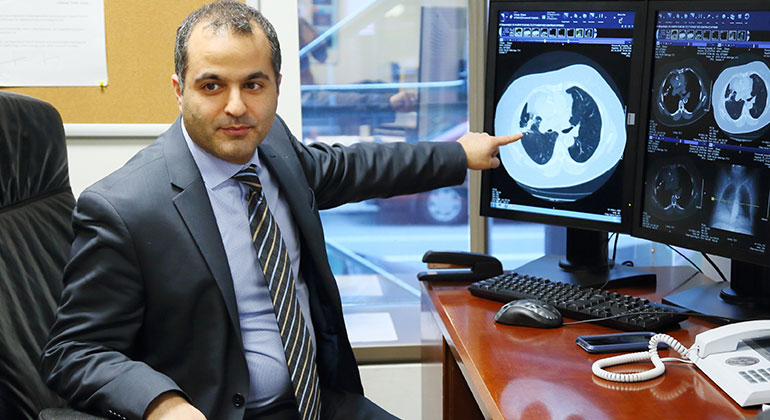Thoracic Surgery Treatments

We often treat lung and esophageal cancer, thymoma, and excessive sweating (hyperhidrosis) with thoracic surgery. The thoracic surgeons at The Mount Sinai Hospital have pioneered some of the latest thoracic surgical techniques. The approaches we use most often include:
Lung Cancer and Mesothelioma Treatments
We use several approaches to treat lung cancer and mesothelioma. These include:
Video-assisted thoracic surgery (VATS) lobectomy: A form of minimally invasive surgery, this procedure involves removing a section of lung. We use it most often to treat lung cancer. Traditionally, we have cut between the ribs and spread them open so we could see into the chest. This procedure is called thoracotomy. A VATS lobectomy is far less invasive. We make a few small incisions and do not need to spread the ribs. This reduces your recovery time and increases overall quality of life.
Extrapleural pneumonectomy: We remove the diseased lung, the chest wall lining (parietal pleura), part of the lining of the heart (pericardium), and part of the diaphragm. It is a complex operation. It helps patients with early stage mesothelioma.
Pleurectomy/decortications: A lung-sparing operation, it works for mesothelioma. We remove the parietal pleura (a parietal pleurectomy), the lung lining (visceral pleura), part of the pericardium, and part of the diaphragm. Our goal is to free the underlying lung so it can expand and fill the pleural cavity.
Esophageal Cancer
Minimally invasive esophagectomy: Developed more than a decade ago, it is only used at a few specialized centers. We use laparoscopy and video-assisted thoracoscopic surgery (VATS) to remove the esophagus and replace it with the stomach.
Chemotherapy and radiation: Chemotherapy uses drugs to kill cancer cells, often by stopping them from reproducing. Radiation therapy uses beams such as high-energy X-rays, to kill cancer cells. We use these two methods together to treat esophageal cancer.
Thymoma
Thymectomy: Removal of the thymus gland to treat myasthenia gravis. The standard approach is a sternotomy, which involves cutting through the breastbone. VATS thymectomy is a minimally invasive approach that uses small incisions. We remove the thymus with the aid of a camera.
Excessive Sweating (Hyperhidrosis)
Endoscopic Thoracic Sympathectomy (ETS): Bilateral ETS permanently treats excessive sweating of the hands and armpit (axilla), a condition called hyperhidrosis. Using small instruments, the surgeon inserts a small telescope attached to a camera and a dissection device into the chest cavity. Then our surgeon cuts the sympathetic nerve. ETS is a permanent and cost-effective approach.